 |
|
|
|
|
|
-
There are two main types of primary lung cancer; small cell and non small cell.
-
Small cell lung cancer is sometimes called ‘oat-cell’ carcinoma because its cells have a distinctive oat shape.
-
There are three main types of non-small cell lung cancer
-
Squamous cell carcinoma – It develops in the cells which line the airways.
-
Adenocarcinoma – develops from the cells which produce mucus in the lining of the airways.
-
Large cell carcinoma gets its name from the large, rounded cells that are seen when they are examined under the microscope.
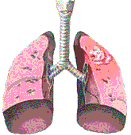 |
| Source:www.health.allrefer.com |
A less common type of cancer that can affect the covering of the lungs is called mesothelioma. It is a cancer of the membrane which covers the surface of the lungs and lines the inside of the chest.
|
| Top |
| |
-
Cancer that begins in the colon is called colon cancer and cancer that begins in the rectum is called rectal cancer.
-
Cancer affecting either of these organs may also be called colorectal cancer.
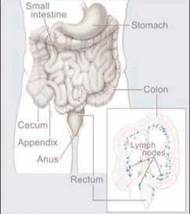 |
Source:www.health.allrefer.com |
-
When colorectal cancer spreads outside the colon or rectum, cancer cells are often found in the nearby lymph nodes.
-
If cancer cells have reached these nodes, they may also spread to other lymph nodes, the liver or other organs.
|
| Top |
|
-
The prostrate is a part of man’s reproductive system. It is located in front of the rectum and under the bladder. A healthy prostrate is about the size of a walnut and is shaped like a donut.
-
Male hormones make the prostrate grow.
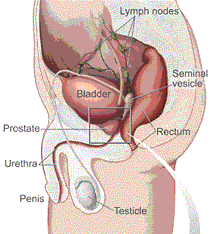 |
Source:www.health.allrefer.com |
-
No one knows the exact causes of prostrate cancer. It is clear that prostrate cancer is not contagious.
-
Age is the strongest risk factor for prostrate cancer. This disease is rare in men younger than 45 but the chance of getting it goes up sharply as man gets older.
-
Having abnormal cells called high-grade prostratic intraepithelial neoplasia may increase the risk of prostrate cancer. These cells look abnormal under a microscope.
|
| Top |
|
-
The uterine cervix is the lower, narrow part of the uterus (womb) that connects the uterus with vagina. It is part of the female reproductive system.
-
Cervical cancer usually develops slowly over time. Before cancer appears in the cervix, the cells of the cervix go through changes in which abnormal cells begin to appear in the cervical tissue. Later, cancer cells start to grow and spread more deeply into the cervix and to the surrounding areas.
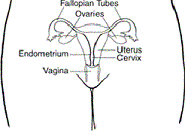 |
Source:www.health.allrefer.com |
Many cases of cervical cancer are associated with known risk factors such as
-
HPV infection,
-
sexual history,
-
screening history,
-
smoking and diet.
|
| Top |
|
-
The most common type of skin cancer is called melanoma.
-
Melanoma is a type of cancer that forms in melanocytes (pigment producing cells)
-
Of the many different types of melanoma, most are seen in the skin including nail beds, soles of the feet and scalp, eye, anal canal, rectum and vagina
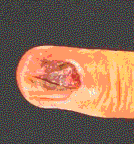 |
Source:www.health.allrefer.com |
-
Other types of skin cancer include
-
Cutaneous T-cell Lymphoma,
-
Mycosis fungoides,
-
Kaposi’s sarcoma
-
Skin cancer occurs mainly in people with fair skin, light eyes and those who tend to freckle or burn easily during and after exposure to sunlight.
|
| Top |
|
-
Tongue is the most common site of oral cancer. Typically the side of the tongue is involved.
-
The floor of the mouth is next in the order followed by inside of the cheeks.
-
Treatment of oral cancer is best undertaken at the earliest stage. This maximizes chances of successful treatment.
|
 |
Source:www.health.allrefer.com |
-
Smaller areas may be treated by radiation or surgery while larger areas will often necessitate combined surgery.
-
Prevention can be achieved by avoiding risk factors – refraining from all tobacco products and consuming alcohol in moderation.
|
| Top |
|
-
Breast cancer is where cancerous (malignant) cells are found in the breast tissue.
-
It is the second most common cancer around the world after lung cancer and its incidence increases with age.
-
90% of women with breast cancer have tumors due to spontaneous new mutation arising in their breast tissue as they age. The cause of these mutations is not known. Men can get breast cancer, although this is very rare.
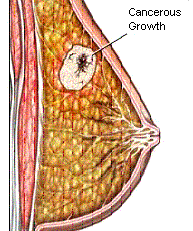 |
Source:www.health.allrefer.com |
-
For every man who is diagnosed, over 100 women are found to have breast cancer.
-
10% of women with breast cancer have an inherited risk for cancer due to genes passed on from their parents.
-
Genes involved, BRCA1 and BRCA2, are thought to be tumor suppressor genes.
|
| Top |
|
|
| Top |
|
| RISK FACTORS |
GROUP with % of Occurrence |
Age |
Elderly individuals - 10% |
Geographical Location |
Developed countries - 5% |
Breast Density |
Extensive breast dense tissue - 5% |
Age at Menarche |
Before age - 11 YRS 3% |
Age at Menopause |
Age after - 54 YRS 2% |
Age at 1st Pregnancy |
First child - after 40 YRS 3% |
Previous Benign Breast Disease |
ATYPICAL Increase in cell number 4-5% |
Pre-menopause |
HIGH B.M.I - 0.7% |
Post-menopause |
HIGH B.M.I - 2% |
Alcohol Consumption |
Daily Drink - 7% |
Exposure to Ionizing radiation |
Exposure of Young Girls - after 10 Yrs of Age 3% |
Breast Feeding |
Women who do not Breast Feed - 4.3% |
Use of Hormone therapy |
Current Users of oral contraceptives or exogenous hormones and during pregnancy: Diethylstilbestrol 4-5% |
|
| Top |
|
-
Obesity: Being overweight increases the risk, especially after reaching menopause.
-
Exercise: Exercise can lower breast cancer risk by about 60% in adults.
-
Breastfeeding: Studies have shown that breastfeeding lowers breast cancer risk.
-
Alcohol: Alcohol is clearly linked with an increased risk of breast cancer. Those who have 2 to 5 drinks daily have about 1½ times the risk breast cancer.
|
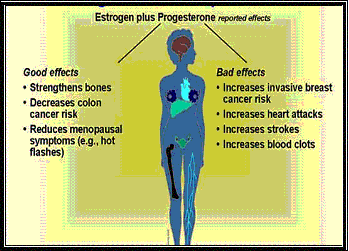 |
Source: www.nci.org |
Estrogen and Progestrone Replacement |
-
Long term usage of Hormone Replacement Therapy (HRT) for the relief of menopause symptoms, increases the risk of breast cancer.
-
Studies on birth control pills have shown that women using these have an increased risk of getting breast cancer.
|
| Top |
|
 |
-
Mutations may cause some cells to become cancerous. Up to 10% of breast cancer cases are hereditary.
-
BRCA1 gene mutations account for 5% of all breast cancer cases.
-
Mutation in HER2 (human epidermal growth factor receptor 2) causes increased cell growth and reproduction. Affects 25% to 30% of breast cancer patients.
-
Mutations of p53 gene also increase a woman’s risk of breast cancer.
|
|
| Top |
|
-
A suspicious sign on a mammogram or a lump in the breast.
-
Genetic analysis –Screening for mutations of BRCA1/BRCA2 genes.
-
A biopsy of the abnormal tissue.
-
A careful physical examination for :
-
Size of tumor in breast.
-
Lymph node enlargement under arm.
-
Changes in texture of breast skin (irritation or dimpling).
-
Tenderness or breast discharge.
|
|
-
Surgery: Surgery offers the greatest chance for cure for many types of cancer. The purpose of surgery is to remove as much of the cancer as possible.
-
Radiation: High-energy particles or waves, such as x-rays or gamma rays, to destroy or damage cancer cells. Radiation therapy may be used after surgery or less often to reduce the size of a tumor before surgery. A suspicious sign on a mammogram or a lump in the breast.
-
Chemotherapy: It is the use of medicines (drugs) to treat cancer. Systemic chemotherapy uses anticancer drugs that are usually given into a vein or by mouth. These drugs enter the bloodstream and reach all areas of the body e.g: busulfan, isplatin,carboplatin,chlorambucil,dacarbazine ,cyclophosphamide ifosfamide.
-
Hormone Therapy: is treatment with hormones (chemicals in the body which regulate body functional balance), drugs that interfere with hormone production or hormone action, or surgical removal of hormone-producing glands to kill cancer cells or slow their growth e.g: estrogen ,tamoxifen, aromatase inhibitors.
-
Biological Therapy: diagnosis for presence of HER-2/neu ,a cell surface protein that some breast cancers express. Drug Herceptin binds to this protein and prevents cancer.
CHEMOTHERAPY drugs interfere with the cancer cells' ability to grow or multiply. Different groups of drugs act on cells in different ways.Ideal anticancer drug should be able to kill tumor cell and be harmless for any normal cell.

Source :PubMed Books
Drugs entering a cell via different mechanisms |
| Top |
The side effects of chemotherapy :
|
-
Feeling tired (fatigue, caused by a shortage of red blood cells)
-
Nausea and vomiting
-
Loss of appetite and hair loss
-
Mouth sores
-
Changes in menstrual cycle (this could be permanent)
-
A higher risk of infection (from a shortage of white blood cells)
-
Bruising or bleeding after minor cuts (from a shortage of blood platelets).
|
| Top |
HORMONAL THERAPY FOR BREAST CANCER |
-
Hormones are substances formed in endocrine organs and they activate specific organs when transported by blood.
-
Hormones attach themselves to receptors on cell surface and send chemical messages to the nucleus with the help of proteins inside the cells.
-
Artificially synthesized compounds that mimic natural hormones produce the same response.
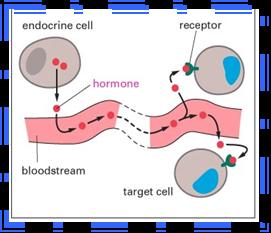 |
Source: accessexcellence.org |
Hormone effector pathway in the body |
-
Hormone replacement therapy (HRT) is giving synthetic estrogen and progesterone (called progestin) designed to "replace" a woman's depleting hormone levels.
-
However clinical evidences support a link between HRT and an increased risk for breast cancer.
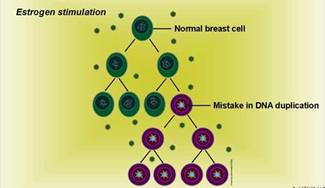 |
Source : www.nci.org |
Estrogen Induced Proliferation and Spontaneous Mutation |
-
Molecular Mechanism of Action of Estrogen Hormone
-
Estrogen binds to Estrogen receptor present on cell membrane and forms a complex.
-
This complex binds to Estrogen responsive element (a region in DNA). This binding leads to synthesis of new proteins which alter cellular appearance.
-
In normal cells estrogen receptors regulate breast cell growth and development.
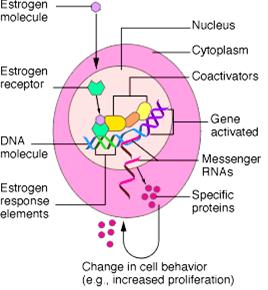 |
Source :www.nci.org |
Mechanism of estrogen hormone action |
-
Approximately 70% of breast tumors contain estrogen receptors. These breast cancers are called "estrogen receptor positive" tumors.
|
| Top |
|
| Target |
Mechanism of Action |
Association with Breast Cancer |
Structure (PDB ID) |
DRUG (if any) |
| ESTROGEN RECEPTOR |
In normal cells estrogen receptors regulate breast cell growth and development |
Breast cell growth and development |
1ERE |
Tamoxifen |
| HER2(Human Epidermal growth factor Receptor-2) |
It sends signals directing cell growth from the outside of the cell to the nucleus inside the cell |
Responsible for 20-30% cases.Genetic alteration in the HER2 gene produces an increased amount of the growth factor receptor protein on the tumor cell surface |
1N8Z |
Herceptin® (Trastuzumab) |
| DING protein (N-terminal amino acid sequence Asp-Ile-Asn-Gly) |
Yet to be defined. binds to genistein with high affinity |
Isolated from human breast cancer cells. Its function remains to be established
|
Not known
|
Genistein
|
IGF-1R (insulin-like growth factor-I receptor) |
It is a membrane receptor (tyrosine kinase) stimulate proliferation, promote angiogenesis and metastasis, and inhibit apoptosis |
It is antiapoptotic and in some cases through induction of new metastatic pathways |
1IGR |
IGF receptor requires activation by ligand. Anti-IGF1R antibodies (like EM164) and IGF1R tyrosine kinase inhibitors will be new drug candidates |
| Bag1L (Bcl-2 associated gene) |
BAG-1 is a protein that interacts with steroid hormone receptors. BAG-1L is functionally similiar BAG-1 |
i) Bag1L interacts with Estrogen Receptor a and ß to cause the target expression in response to hormones. ii) Its high level indicates active ER function |
1HX1 |
Small molecules to interfere with protein-protein interactions can be a strategy to inactivate Bag1 regulation of ERs |
BRK (Breast tumor kinase) |
Intracellular protein-tyrosine kinase (non receptor) |
i) Overexpressed in 60% of human breast cancers
ii) Role of Brk is under investigation
iii) Brk modifies a protein Sam68; this protein is associated with a cellular structure (called Sam68 nuclear body) that is present only in cancer cells
iv) Like c-Src, high activity of Brk leads to activation Epidermal Growth Factor
|
1RJA |
No drugs available yet |
NGF receptors (Nerve growth factor) |
Proteins regulating brain development and function, nerve cell regulation, growth and maintenance |
i) survival and proliferation of breast cancer cells are strongly increased by NGF
ii) TrkA receptor is known to mediate the cell growth by activating the Ras/Raf/
mitogen-activated protein kinase pathway
iii)p75 has been shown to regulate TrkA activation by NGF |
1SG1(p75), 1HE7(TrkA) |
No drugs available yet |
PARP (poly (ADP-ribose) polymerase |
PARP gets activated by DNA damage and carries out the back up DNA repair mechanism |
i) a significant link between strong PARP gene overexpression and low genetic instability in human breast carcinomas points to a possible involvement of this gene in DNA repair in human breast tumor cells
ii) PARP carries out repair of DNA which is damaged by mutations in the BRCA1 and BRCA2 genes and allows tumors to grow |
1UW0 |
No drugs available yet |
IGF-1R (insulin-like growth factor I receptor) |
It is a membrane receptor (tyrosine kinase) that indirectly stimulates proliferation, promote angiogenesis and metastasis, and inhibit apoptosis. |
It is coexpressed with EGFR in most human primary breast carcinomas |
1IGR |
No drugs available yet |
IGF-1R (insulin-like growth factor I receptor) |
It is a membrane receptor (tyrosine kinase) that indirectly stimulates proliferation, promote angiogenesis and metastasis, and inhibit apoptosis. |
It is coexpressed with EGFR in most human primary breast carcinomas |
1IGR |
No drugs available yet |
| Epidermal growth factor receptors (EGFR or HER1 or ErbB1) |
i)It is a growth factor receptor
ii)EGFR forms dimers upon ligand binding and undergoes autop
hosphorylation to become fully active
iii)It leads to activation of signal transduction pathways that
result in changes in cellular proliferation and differentiation |
i) High levels of EGFR are present in breast tumors
ii) Lead to angiogenesis, metastasis and an inhibition of apoptosis in cancerous breast tissues
iii) The expression of EGFR by these tumors is frequently associated with high tumour grade, elevated growth fraction, an inverse relationship with oestrogen receptor, poor response to endocrine therapy, and reduced survival | 9 structures available in PDB (1I31, 1I8I, 1I8K, 1IVO, 1M14, 1M17, 1MOX, 1XKK, 1YY9) |
i) Two approaches are in clinical development: monoclonal antibodies and small molecule inhibitors of the EGFR tyrosine kinase enzyme
ii)ZD1839 (‘Iressa’), CP358,774 and PKI-116 are tyrosine kinase inhibitors- trials in progress
|
Aromatases |
i)Convert androgen into estrogen in postmen
opausal women ii)Major source of estrogen in breast, fat, liver, muscle |
Acts as source of estrogen thereby facilitating breast cancer |
Not known |
Anastrozole (non-steroidal agent), Exemestane (steroidal agent) |
|
| Top |
|
| Class |
Mode of Action |
Examples (Generic names) |
SERMs (Selective Estrogen-Receptor Modulators) |
Binds estrogen receptors in breast cancer cells, starving cancer cells of estrogen |
Tamoxifen (Nolvadex)
Evista (raloxifene)
Fareston (toremifene) |
Aromatase Inhibitors |
Bind with certain proteins on breast cancer cells, preventing their growth |
Aromasin (exemestane)
Femara (letrozole)
Arimidex (anastrozole)
Megace (megestrol) |
Other Hormonal Therapies/ SERD’s |
Treat breast cancers that are dependent on estrogen for survival |
Zoladex (goserelin acetate)
Faslodex (fulvestrant) |
|
-
Selective estrogen receptor modulators, or SERMs, are drugs which selectively stimulate or inhibit the estrogen receptors of different target tissues.
-
SERM inhibits the estrogen receptor and therefore avoid cancer growth in breast cells.
|
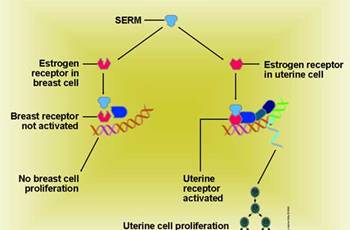 |
Source:www.nci.org |
Mode of action of SERMs |
-
However it activates the estrogen receptor present in uterine cells thus causing cancerous growth over there.
-
The most prevalent SERM with a high rate of success in breast cancer patients : Tamoxifen.
|
-
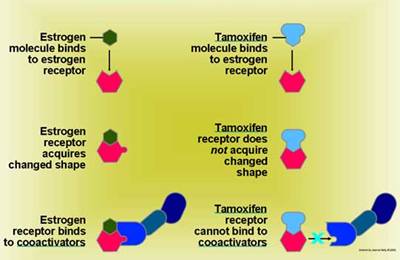 |
Source: www.nci.org |
Mechanism of action of Tamoxifen vis-a vis Estrogen |
-
By interfering with estrogen receptors in this way, tamoxifen blocks the ability of estrogen to cause breast cancer.
-
In 1992 a study at the National Cancer Institute, showed, more than 13,000 healthy women to be at high risk for breast cancer.
-
Half the women were given tamoxifen . After 5 years, the group receiving tamoxifen had a lower rate of breast cancer.
-
Other Good effects of Tamoxifen
-
Cancer causing effect of Tamoxifen
-
Tamoxifen , an anti-tumour, also mimics the actions of estrogen in other tissues such as the uterus.
-
Its estrogen-like effects on the uterus stimulate proliferation of cells in uterus and increase the risk of uterine cancer.
-
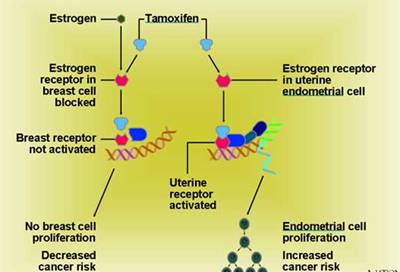 |
Source :www.nci.org |
Effects of Tamoxifen (SERM) upon different tissues |
-
Bad effects of tamoxifen
-
Increases Uterus cancer risk
-
Increases Blood clot risk
-
Development of Tamoxifen resistant breast cancer cells
|
| Top |
| Current Drug Status |
-
Need for Better Serum
-
Aromatase Inhibitors
|
|
|
|
|

